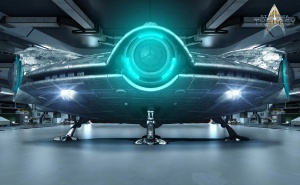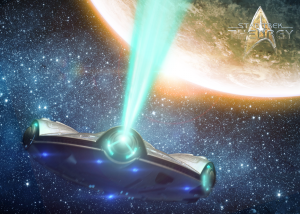Overseer-class Research Saucer
From Star Trek: Theurgy Wiki
Overseers were a sturdy class of survey vessels built for undetected observation. The KRK-9009 series was built specifically to observe pre-contact species on class H, M, O, and P planets. During the Sheromi contact with Asurians, many motherships still held MK IV versions of the ships despite their decommissioning. The Asurians now fly a handful of these saucers for the purpose of pirating and battle.
The Overseer class is infamous for having started the pop-culture fad of 'flying saucers' on Earth. Sheromi used the MK IV saucers for observing humans and consequently left an imprint of their ships in human culture. A handful of younger cultures also share the same cultural phenomenon for the same reasons.
Production History
The Sheromi employ a number of research and exploration vessels in their never-ending mission to continue what the Preservers started, but dependable spacecraft were scarce. Their older ships did not often survive the transition from space to an atmosphere, and if they did, their observational ships would sometimes be spotted, which would make much of their research invalid. In civilizations with primitive weaponry and aircraft, they found that their older ships could not leave fast enough. Often the ship would be damaged, the sensitive, fragile instruments inside would be damaged, or they'd lose the ship altogether. The Overseer class arose from the need for a quiet, stealthy scientific vessel that would remain largely untouched by the kinetic weaponry of most primitive alien civilizations.
The Overseer class made it's first debut in 1888 as a purely experimental prototype, deployed on a select few pre-sentient planets for the purpose of demonstrating the effectiveness of the new craft. The design proved highly popular, with the only flaws being the high power consumption of the engines and the unusual shape of the craft. Soon, Sheromi Motherships employed the use of Overseer class saucers almost universally for the purpose of observation. Their cloaking systems made them the favored ship of researchers, as it allowed them to observe without being observed. The cloaking system was deemed so important that all ships regardless of make received almost continual updates until 2045. Ships with an out-of-date system are rare--saucers with no system are even rarer.
Later developments in 1960 and 1985 led to the development of the MK II and MK III Overseers. The MK II Overseer had its RF Cavity Thruster engine replaced with a Gravitic displacement engine, giving the Overseer class its trademark maneuverability and decreasing the amount of power consumed by the engine at any given time. The MK II was also the first class to use the liquid alloy known as Kkrek.
The MK III received an impulse engine upgrade and was also the first class with a tractor beam tuned specifically for organic matter. As the Sheromi studied more and more with sentient beings, it became important to develop some means of picking samples, hence the tractor beam.
The MK IV and the final upgrade before it's eventual decommissioning had a basic weapons system to take down potential pursuers and a complete overhaul of the crude navigational beam that previous makes had. Now each ship came equipped with graviton beams of a caliber not yet manufactured by Starfleet. Another minor addition was the use of a gentle blue floodlight that activated whenever the short range organic matter (SROM) beam activated, as humans didn't respond to pheromones as well as they did strange lights. This was in addition to the pheromone emitters that all previous makes had. The light could be removed or disabled as needed.
All Overseer saucers are assigned to a Mothership and remain docked with the Mothership when not in use.
Exterior Features
The Overseer class carries a few features considered new or unusual compared to Federation starships, since the Sheromi are not a part of the Federation and do not have contact with them.
Kkrek Alloy
Kkrek is a thin, silver-translucent, non-Newtonian liquid at room temperature, a mixture of both natural and lab-created elements. It is a super-hydrophobic alloy that does not bond easily in the presence of other elements. It hardens permanently when exposed to high heats. The surface of heated Kkrek is extremely smooth and reduces friction to near-zero. It can sometimes feel chilly to the touch.
Kkrek alloy coating deteriorates over the span of several centuries, though hard strikes to the surface of the alloy can sometimes break the coating, leaving the surface below open to damage. Although rain and wind slide right off the alloy, hail can sometimes cause hairpin cracks that will reduce the coating's overall effectiveness, and large meteors can sometimes tear off chunks of coating all together.
It is possible to strip and re-coat a saucer, but it takes a few days to complete.
Quadruple Deflector Dishes
Each Saucer is outfitted with four deflector dishes across the widest part of the saucer. Each deflector dish has the same capabilities as all the others. There are virtually no differences in a freshly-manufactured Saucer's deflector dishes.
It is possible to operate one dish at a time, or to sync all dishes. Losing a dish does not hinder the others, but may reduce the allowed range of certain abilities.
Most of the ship's offensive capabilities come from the deflector dishes. They are considered one of the most important parts on the ship and, when Overseers were in production, it was a requirement to constantly monitor and repair the dishes. If shields are ever broken, the dishes are usually the first to go due to their size.
Gravitational Forcefield
Saucers carry two kinds of shielding by default, both stemming from the deflector dishes. Overseer deflector shielding is similar to Starfleet deflector shielding.
The Overseer gravitational force field is a separate shielding system used specifically to deflect pre-warp weaponry, such as missiles, bullets, arrows, and rocks.
The kinetic shielding is a powerful force spread out over an area just a little larger than the deflector shielding. It is capable of exerting approximately 30-50 tons of force on a given area, depending on how much power is routed to the kinetic shielding.
While the ship is moving, it is possible for the ship to run into another mass, using this force field. A saucer moving 50 MPH with kinetics at 30 tons will exert about the damage one would expect from a very heavy thing moving very fast. Liftoff from the ground with kinetics on will leave an imprint on the ground. This leads observers to believe the ship itself is 30 tons.
Kinetics and deflector shielding can both be active at the same time, but neither can be at full power while the other is operating.
Organic Tractor Beam
The organic tractor beam is a subtype of tractor beam meant specifically for attracting organic matter. Standard tractor beams are built for pulling synthetic matter. Common targets include asteroids, debris, and other ships. It's generally used to hold, push, or pull. The gravitonic pressure exerted by the standard tractor beam is enough to crush or tear apart the average organic being. The OTB is meant to be used to freeze and lift organic beings into the hull of the ship for tag/release, experimental, or probing purposes.
It is important to note that the OTB is a separate feature from the standard tractor beam. Only one beam can work at a time. The OTB includes pheromone emitters and floodlights that typically activate with the beam, the standard tractor beam lacks these features.
Sheromi in general do not use transporters for the purpose of capturing targets on the overseer class ships due to the complex installation that a transporter system requires. In terms of cost-effectiveness and power usage, using an already existing feature is more efficient.
Entry Ramp
In addition to teleportation technology, Saucers all use an entry/exit ramp located on the underside of their hull. When on ground, this ramp can be used to load people and goods on and off. The ramp also slides aside to allow in persons or objects being 'abducted'
Interior Features
Overseers are short-range craft, and although crew quarters can be added in at the expense of lab or holding cell space, they do not come standard with crew quarters.
Overseers generally have three rooms. The aft-most room is for holding cells and miscellaneous storage, the center-most room is the lab, and the forward-most room is the cockpit.
Due to the compact nature of a saucer, it's difficult to access engineering. There are a few compartments, similar to jeffries tubes, in the walls of the lab that can be used to access the warp core and other features of the ship, but they are narrow entryways and working in engineering is cramped.
Laboratory
As a primarily scientific vessel, all Overseers have a laboratory of some sort. The majority of the saucer's square footage is dedicated to the laboratory, typically decked out with an examination table that retracts into the ceiling, modular equipment, and holding cells.
Modular Lab Equipment
Almost all lab equipment in a Saucer, regardless of make, is removable. As science and technology speeds along the road of progress, the Sheromi did not want to create a saucer that would be obsolete within the next five years simply because the equipment within the lab was outdated. The simplest solution was to make all scientific equipment within the lab removable and replaceable.
This also adds the option of customization for each saucer. A saucer dedicated purely to catch/release could remove any equipment not related to their mission and replace it, if need be.
The sensor suite on any Overseer class is also removable and replaceable, however replacing the sensor suite is slightly more difficult and time consuming due to the compact wiring of the Overseer class.
Holding Cells
It is important to note that holding cells, in this context, do not refer to a brig of any sort. Holding cells were used for short term containment of test subjects. They're kept in a room near the aft of the saucer, out of view of the laboratory. The cell walls are all energy-based, so size and shape of a holding cell can be customized. Each cell is given it's own environmental system to provide the optimal environment for the subject.
Transporters
Overseer class saucers do not have a transporter pad by default. Instead, each crewmember is given a handheld, one way, one-time-use transporter device, typically set to teleport the user to the transporter room aboard the Saucer's Mothership. The devices can be reprogrammed to teleport elsewhere.


